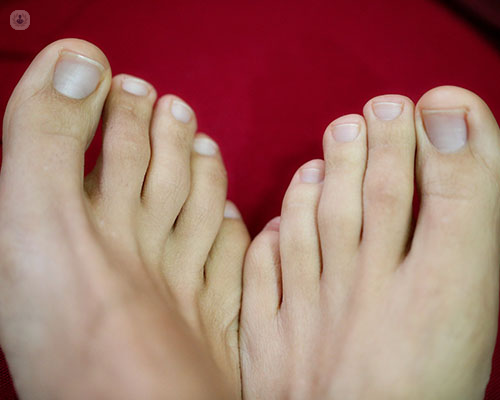What are corns and hammer, claw, and mallet toes?
Written by:We rely on our feet every day to get from point A to point B and over time, our feet develop some wear and tear. Fortunately, the damage done to the skin and bones on our feet and toes can be treated. Mr Simon W Sturdee, an orthopaedic surgeon, explains what these are, the causes and how to remove them.
What are corns?
Corns are thick, tough portions of skin and are usually uncomfortable and painful. They form in areas of your feet that don’t endure any weight pressed onto them, such as the areas between your toes, the sides of your toes and the top.

How do corns form?
The pressure put on the skin from improper fitting shoes is generally the cause of corns.
- A hard corn occurs when the skin on the toes, characteristically over the joints (knuckles), is dry and rubbed against footwear.
- A soft corn occurs when the skin is moist, typically in between the toes.
What are lesser toe deformities and how do they occur?
A lesser toe deformity is one that affects any toe other than the big toe. Generally, the toe can become misshapen and distorted. Typical causes are:
- Muscular weakness
- Congenital diseases (an illness present from birth)
- Arthritis
- Poorly fitting and/or tight shoes
- High heeled shoes that are pointed at the toes can be particularly problematic as these cause the toes to heap together, resulting in additional pressure that makes the joints contract.
Of the lesser toe deformities, three are particularly common:
There are three bones at the end of your toe. In the case of a hammer toe, the bone at the tip is flat, yet the bone after the knuckle is at a downward angle, and the bone from the foot to knuckle is pointing upward. This occurs due to a contracting tendon. From a side-on view, the toe’s shape would be a ‘sharp’ arch rather than a straight line.

Claw toe
A claw toe is very similar to its name. The toe arches round like a claw, and develops due to a foot tendon contracting. From a side-on view, the bone from the foot to the knuckle points upwards, but from the knuckle to the tip as well as the tip are at a downward angle.

Mallet toe
Similar with the hammer and claw toe, a mallet toe forms because a tendon in the foot is contracting. The toe is generally straight, however the tip points down.
How to treat lesser toe deformities
The most basic method is to adapt the footwear being worn to shoes that provide adequate space for the toes. Options are larger, wider shoes or open-toed sandals.
Additionally, cushioning pads and devices can be used to lessen the pressure being placed on the joint. These can be found in local pharmacies.
If the corn is not dealt with and breaks down, an ulcer can eventually develop underneath the skin. This leaves the toe vulnerable to infection.
Is surgery necessary?
If the previously mentioned methods fail to relieve pain and pressure on the toe, surgery may be recommended to straighten the toe to ensure that it will lie more comfortably in the shoe.
This surgery is not serious and can be performed while the patient is under general anaesthetic or local anaesthetic.
What happens during surgery?
The type of procedure depends on the type of lesser toe deformity. Usually, a tendon is released and then a wire is positioned along the joints to hold them together, or a wire is placed to hold the joints still so that they will fuse together properly.
The wire is bent around the tip of the toe but a dressing will cover it. After around 4-6 weeks, the wire is then removed at the clinic.
If you’ve been suffering with painful corns and toe deformities, don’t wait until the problem becomes worse. You can get in contact with Mr Simon Sturdee on his Top Doctors profile and book an appointment!


